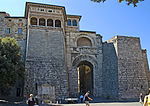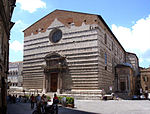University of Perugia
1308 establishments in EuropeEducation in UmbriaEducational institutions established in the 14th centuryUniversity of Perugia

University of Perugia (Italian Università degli Studi di Perugia) is a public-owned university based in Perugia, Italy. It was founded in 1308, as attested by the Bull issued by Pope Clement V certifying the birth of the Studium Generale. The official seal of the university portraits Saint Herculan, one of the saint patrons, and the rampant crowned griffin, which is the city symbol: they represent the ecclesiastical and civil powers, respectively, which gave rise to the university in the Middle Ages.
Excerpt from the Wikipedia article University of Perugia (License: CC BY-SA 3.0, Authors, Images).University of Perugia
Piazza dell'Università, Perugia Sant'Erminio
Geographical coordinates (GPS) Address Nearby Places Show on map
Geographical coordinates (GPS)
| Latitude | Longitude |
|---|---|
| N 43.116 ° | E 12.386 ° |
Address
Piazza dell'Università
06122 Perugia, Sant'Erminio
Umbria, Italy
Open on Google Maps









